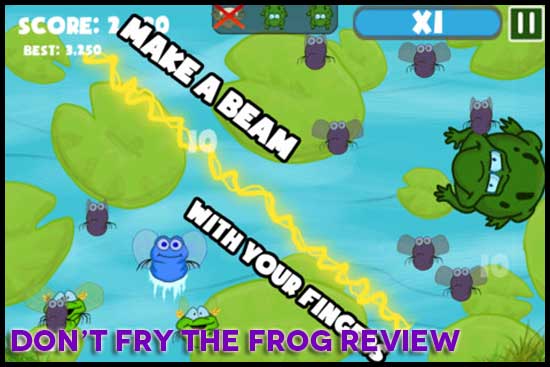Our Indie Game Developer Interview is back with a bang, this time featuring the folks from BlackTorch Games who are responsible for a poor frog’s diet programme in Don’t Fry the Frog! for the iPhone (read our review over here). Without further ado, here’s the interview:
Nine Over Ten 9/10: Tell us more about yourselves and how you started developing mobile games?
Blacktorch Games: All the founders of Blacktorch Games met by taking classes that were offered at the NYU Game Center. We eventually started working on teams together and realized we could really get things done, so upon graduation we decided to attempt to make our first iOS game. The rest of the team came together through people we knew from our personal circles. Our artist, Tim Levine, is actually an orthodontist by trade.
9/10: What was the idea behind Don’t Fry the Frog?
BT: For Don’t Fry the Frog! we particularly wanted to design a game that used multi-touch as part of its core mechanic. Multi-touch, interacting with a touch screen by touching it with several digits in different places on-screen at the same time, has been used only rarely in mobile games. The actual idea for the design came to us very quickly.
While walking on the sidewalk outside of Tisch, Charlie mentioned that we should really use multi-touch in a game to do something like have the player touch the screen in two places and have an electric beam form between his or her fingers. I jumped on this, saying that we could use the beam to try to fry flies before a hungry frog could eat them, that the game would be complicated by the frog growing in size, and requiring the player to avoid frying him.
We even came up with the name in that moment – I suggested Don’t Fry the Frog! and it stuck. The core of the game has remained true to that initial design through to the present.
9/10: How has the response been to Don’t Fry the Frog on the iTunes App Store? Could you describe the process of marketing your games?
BT: The response to our app has been really great. Don’t Fry the Frog has been downloaded thousands of times and we are receiving analytic data from all parts of the world and it’s exciting to know that someone on the other side of the planet is enjoying a game that we made. A really crazy stat that we like to talk about is that the frog has been fried more than 50,000 times. As for marketing, we had the great fortune of partnering up with TriplePoint PR.
They really showed us the ropes when it came to getting our message out there and having people relate to our cause. Other than the outreach they did, we also tapped our personal networks and tried to put our app in the spotlight whenever we could. Reaching out to local game dev communities was one of the best things we could have done because it put us on the minds of a lot of great developers and media in our area.
9/10: Could you share with us a little on what you’ll be working on next? Any plans for releasing games on other platforms?
BT: We have another game that is currently part-way through development, a gem-swapping puzzle game called Delve. It bears some resemblance to existing tile-matching games like Bejeweled, but ours has an extra bit of a kick. Players swap gems into groups of the same color, but then use those groups to set off explosions which clear gems from the board. These explosions can be chained to create bonus point combos or unlock achievements, and as the players blast through the board, they actually dig downward through large mountain levels, revealing powerful artifact power-ups and dangerous enemies. We’re planning to release Delve on PCs, Windows phones, and Windows tablets initially.
9/10: Any words for aspiring game developers out there?
BT: Make lots of games. The best way to improve your skills in all aspects of game development is to get in there and start slugging it out. This is particularly true even in designing the core mechanic of a game – it’s rare that game concepts come together as cleanly as Don’t Fry the Frog!’s has. Typically the design of the core mechanic is more similar to how the rest of our game was developed – over the course of many iterations. To get the rest of the framework around our core idea working, we tried out many different variations of the game, tweaking and tuning variables throughout to create the particular experience we wanted to give our players. Iteration is the heart of game design.


The interviewee is spot-on when he says that, to be better developers, individuals should produce a lot of games. Applying what they know in theory is the best way to hone their skills in the craft.
[…] Fry The Frog was a pretty straightforward iOS title (we love it by the way, read the review here), one of the founders, Michael T. Astolfi (together with friend Aaron Rasmussen) has just released […]